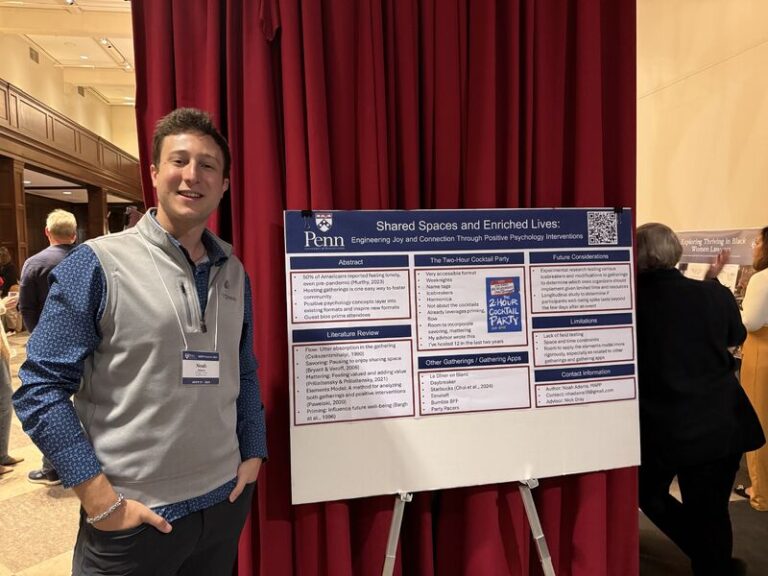Last updated: January 13, 2025
The power of structured social gatherings is gaining academic attention.
Noah Adams, a researcher at the University of Pennsylvania’s Masters of Applied Positive Psychology program, recently analyzed “The 2-Hour Cocktail Party.”
His literature review study explores how my gathering guidelines have the potential to alleviate the loneliness epidemic by fostering meaningful social connections.
Focus Points of Study
Here’s what Adams wanted to explore through this research:
- Analysis of structured social gatherings as positive psychology interventions
- Examination of key elements that make cocktail parties successful
- Study of priming techniques through the use of guest bios
- Investigation of the icebreakers’ role in fostering connection
- Research on the impact of mixing diverse social groups
Core Formula Analysis
Adams directly references the effectiveness of the cocktail party formula, noting:
"It seems that these parties have three main 'active ingredients' that cause them to function: the guest bios, the icebreakers, and the mix of people in attendance."He explains that “the guest bios serve as a priming agent, getting the guests thinking about how they fit into the mix and who they might want to talk to at the party.”
The research highlights the unique approach to timing, quoting that these gatherings are most effective when scheduled “on a Monday, Tuesday, or Wednesday” and noting this is “counterintuitive because most social gatherings tend to occur on Thursday, Friday or Saturday.”
However, as Adams points out, “hosting on the less traditional days means your event will have less competition for people’s attention.”
Notable Academic Observations
Adams identified three main “active ingredients” in my cocktail party formula:
- Guest bio as priming agents
- Icebreakers as attention-shifting tools
- Strategic mixing of attendee groups
Integration with Positive Psychology
His research connects the cocktail party format to established positive psychology concepts. It also notes opportunities for enhancement.
He writes that “while understanding how the existing two-hour cocktail party formula works, there also exists room to maximize its impact by actively incorporating positive psychology concepts.”
Adams explores several key psychological elements:
- Flow States: “Because of the optimal amount of challenge of getting to know new people while being supported by the event structure, guests may be more likely to experience flow.”
- Savoring: Adams suggests “taking a moment of silence to just soak in the energy of the party and be fully present.”
- Mattering: The research notes that the format contributes to “guests’ sense of mattering” through both “feeling valued and adding value.”
- Priming Effects: The study emphasizes how guest bios serve as “priming the event guests with statements about what the event will feel like.”
Research Context
Adams analyzed the concepts in my book as part of a broader study. He wanted to examine various gathering formats and their potential to address the negative impacts of societal isolation.
The loneliness epidemic is real. And really harmful to our health. This study sought to better understand the underlying strengths that exist in selected gathering formats to help foster meaningful connections that reduce loneliness.
According to Adams, my book’s format for gatherings is a great model.
Academic Impact
The inclusion of “The 2-Hour Cocktail Party” in academic research at an institution like UPenn demonstrates the growing recognition of structured social gatherings as valuable tools for building community and fostering meaningful connections.
The study also emphasizes the timeliness of structured gatherings. It cited that “as many as 50% of Americans reported feeling lonely even before the added impact of the pandemic, suggesting that the problem will not simply go away now that pandemic-era lockdowns have ended.”
Findings and Conclusion
Noah Adams’ academic analysis of “The 2-Hour Cocktail Party” reveals several significant findings:
- The structured party formula serves as a viable positive psychology intervention for combating loneliness and building community connections.
- 3 key components drive the format’s success:
- Strategic use of guest bios as priming tools.
- Carefully timed icebreakers to facilitate connections.
- Intentional mixing of diverse social groups.
- The research validates counterintuitive aspects of the format:
- Hosting on weekday evenings rather than weekends.
- Maintaining strict two-hour time limits.
- Using structured elements like name tags and scheduled icebreakers.
- The study connects the party format to established psychological concepts:
- Flow theory in social interactions.
- The practice of savoring experiences.
- Development of community mattering.
- Effective use of social priming.
Adams’ academic examination validates structured social gathering techniques like my own. The 2-hour cocktail party is an effective way to build meaningful connections and alleviate the loneliness epidemic.
As society continues to grapple with increased isolation, his research suggests that intentionally designed social gatherings play a crucial role in fostering community and combating loneliness. I agree.
Thanks to Noah Adams for using my book as a source for this wonderful research.


